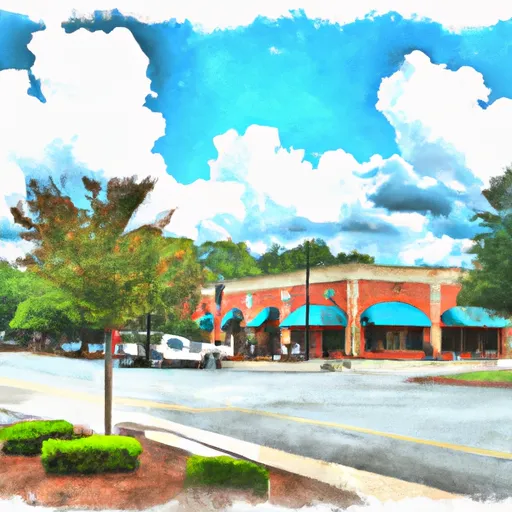-
 Snoflo Premium
Snoflo Premium
Get unlimited access to all our content
With no Ad interruptions! - Start Your Free Trial Login with existing account
Midville
Eden Index
Climate
8.2
•
Recreation
0.7
•
Community
•
Safeguard
3.5/10

Midville, Georgia, located in Burke County, offers a diverse range of outdoor recreation opportunities in a beautiful natural setting. The town experiences a humid subtropical climate, characterized by hot, humid summers and mild winters. Summers are typically long and warm, with temperatures averaging in the 80s°F (27-32°C), while winters are mild, with temperatures in the 50s°F (10-15°C). Midville receives an average annual rainfall of around 46 inches (116 cm), ensuring lush vegetation and abundant water sources.
Hydrologically, Midville benefits from its proximity to the Ogeechee River, which runs through the town. The river provides excellent opportunities for fishing, boating, and kayaking, with species such as largemouth bass and catfish being popular catches. Additionally, the area is rich in wetlands and creeks, attracting wildlife enthusiasts and birdwatchers. The diverse hydrology constituents in and around Midville contribute to a thriving ecosystem and offer a unique outdoor experience.
In addition to water-based activities, Midville boasts numerous outdoor recreational opportunities. The town is surrounded by beautiful forests and parks, offering hiking, camping, and hunting opportunities. Wildlife management areas, such as Tuckahoe Wildlife Management Area, provide ample space for hunters and nature lovers to explore and enjoy the great outdoors. With its favorable climate, abundant water sources, and diverse outdoor offerings, Midville, Georgia, is an ideal destination for nature enthusiasts and adventure seekers.
What is the Eden Index?
The Snoflo Eden Index serves as a comprehensive rating system for regions, evaluating their desirability through a holistic assessment of climate health, outdoor recreation opportunities, and natural disaster risk, acknowledging the profound impact of these factors on livability and well-being.
Climate Health Indicator (CHI): 8.2
Midville receives approximately
1154mm of rain per year,
with humidity levels near 86%
and air temperatures averaging around
19°C.
Midville has a plant hardyness factor of
8, meaning
plants and agriculture in this region tend to thrive here all year round.
By considering the ideal temperature range, reliable water supplies, clean air, and stable seasonal rain or snowpacks, the Climate Health Indicator (CHI) underscores the significance of a healthy climate as the foundation for quality living.
A healthy climate is paramount for ensuring a high quality of life and livability in a region, fostering both physical well-being and environmental harmony. This can be characterized by ideal temperatures, reliable access to water supplies, clean air, and consistent seasonal rain or snowpacks.
Weather Forecast
Streamflow Conditions
Ogeechee
Area Rivers
Ogeechee
Snowpack Depths
Ogeechee
Reservoir Storage Capacity
Ogeechee
Groundwater Levels
Recreational Opportunity Index (ROI): 0.7
The Recreational Opportunity Index (ROI) recognizes the value of outdoor recreational options, such as parks, hiking trails, camping sites, and fishing spots, while acknowledging that climate plays a pivotal role in ensuring the comfort and consistency of these experiences.
Access to outdoor recreational opportunities, encompassing activities such as parks, hiking, camping, and fishing, is crucial for overall well-being, and the climate plays a pivotal role in enabling and enhancing these experiences, ensuring that individuals can engage in nature-based activities comfortably and consistently.
Camping Areas
| Campground | Campsites | Reservations | Toilets | Showers | Elevation |
|---|---|---|---|---|---|
| George L Smith State Park | None | 223 ft | |||
| Gordonia-Alatamaha State Park | None | 187 ft | |||
| Lake Leitner Military | None | 348 ft | |||
| Wildwood County Park | 61 | 447 ft | |||
| Ridge Road - Strom Thurmond Lake | None | 399 ft | |||
| Falling Rocks County Park | 20 | 129 ft | |||
| Winfield - Strom Thurmond Lake | None | 360 ft | |||
| Clay Hill - Strom Thurmond Lake | None | 358 ft | |||
| Petersburg - Strom Thurmond Lake | None | 440 ft | |||
| Mistletoe State Park | None | 431 ft |
Nearby Ski Areas
Catastrophe Safeguard Index (CSI):
The Catastrophe Safeguard Index (CSI) recognizes that natural disaster risk, encompassing floods, fires, hurricanes, and tornadoes, can drastically affect safety and the overall appeal of an area.
The level of natural disaster risk in a region significantly affects safety and the overall livability, with climate change amplifying these risks by potentially increasing the frequency and intensity of events like floods, fires, hurricanes, and tornadoes, thereby posing substantial challenges to community resilience and well-being.
Community Resilience Indicator (CRI):
The Community Resilience Indicator (CRI) recognizes that education, healthcare, and socioeconomics are crucial to the well-being of a region. The CRI acknowledges the profound impact of these elements on residents' overall quality of life. By evaluating educational resources, healthcare accessibility, and economic inclusivity, the index captures the essential aspects that contribute to a thriving community, fostering resident satisfaction, equity, and social cohesion.

